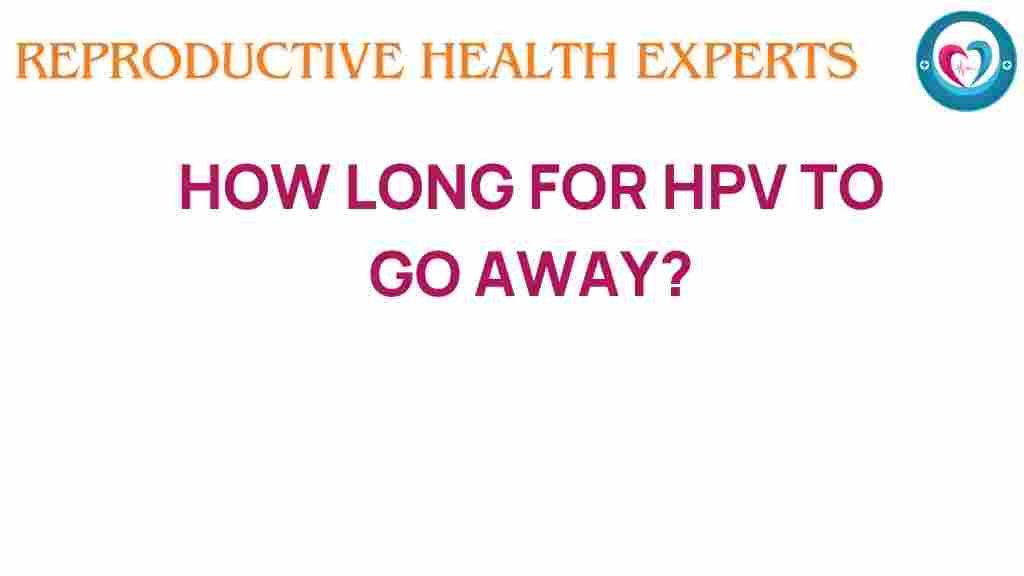Understanding HPV: How Long Until It Disappears?
Human Papillomavirus (HPV) is a group of over 200 related viruses, some of which can lead to serious health issues, including cervical cancer and other types of cancer. This article will delve into the timeline of HPV infection, exploring how long it might take for the virus to disappear from the body, the immune response, treatment options, and preventative measures.
What is HPV?
Human Papillomavirus (HPV) is primarily transmitted through intimate skin-to-skin contact. It’s one of the most common sexually transmitted infections (STIs) worldwide. While most HPV infections are asymptomatic and resolve on their own, certain high-risk strains can lead to various types of cancer, making understanding the timeline of infection and recovery crucial.
Types of HPV
- Low-risk HPV: Types 6 and 11, often causing genital warts.
- High-risk HPV: Types 16 and 18, associated with cervical and other cancers.
HPV Infection Timeline
When discussing the timeline of HPV, it is essential to understand the various stages of infection and recovery. The process can be broken down into several key phases:
1. Exposure and Infection
HPV is typically contracted through sexual contact. After exposure, the virus may remain dormant for weeks, months, or even years before symptoms appear or the immune system responds. The timeline can vary widely among individuals.
2. Immune Response
Once infected, the body’s immune system often recognizes and begins to fight the virus. In many cases, within two years, the immune system clears the virus without any treatment. Factors influencing this timeline include:
- Overall health and immune function
- Smoking and alcohol use
- Co-existing health conditions
3. Persistence of Infection
For some individuals, HPV may persist. This is particularly true for high-risk strains, which can lead to cellular changes and cancer. The persistence of HPV can be affected by:
- Age: Younger individuals often clear the virus faster.
- Gender: Women may have a longer persistence of certain HPV types.
- Immune system status: Those with weakened immune systems may have more difficulty clearing the virus.
HPV Treatment Options
While there is no cure for HPV itself, there are treatment options available for the health issues that arise from the infection. Here’s a breakdown:
1. Genital Warts Treatment
For low-risk HPV strains that cause genital warts, treatments include:
- Topical medications (e.g., imiquimod, podophyllin)
- Cryotherapy (freezing warts off)
- Surgical removal
2. Cervical Precancer Treatment
For high-risk HPV strains that lead to cervical precancer, treatment options include:
- Colposcopy and biopsy to monitor changes
- Loop electrosurgical excision procedure (LEEP) to remove abnormal cells
- Cervical conization if necessary
HPV and Immunity
The body’s immune response plays a critical role in clearing HPV. Here are some factors related to immunity and HPV:
1. Natural Immunity
Most people will clear the infection naturally within two years. This natural immunity is a crucial defense mechanism against the virus.
2. Vaccination
Vaccines such as Gardasil and Cervarix can prevent infection from the most common high-risk HPV types. Vaccination is recommended for preteens and young adults:
- Before sexual activity begins
- Up to age 26 for women and men
Prevention Strategies
Preventing HPV infection is possible through various strategies:
1. Vaccination
As mentioned, getting vaccinated against HPV is one of the best ways to prevent infection.
2. Safe Sexual Practices
Using condoms can lower the risk of transmitting HPV, although it does not eliminate the risk entirely.
3. Regular Health Screenings
For women, regular Pap smears and HPV tests can help detect cervical changes early, leading to timely intervention.
Recovery from HPV
Recovery from HPV can take different amounts of time depending on various factors, including the type of HPV, the individual’s overall health, and their immune response. Here’s a general timeline for recovery:
1. Asymptomatic Infections
For many, HPV infections are asymptomatic and resolve within two years. The immune system typically clears the virus during this period.
2. Persistent Infections
Some individuals may experience persistent infections that require monitoring and treatment. The timeline for these cases can extend beyond two years, necessitating regular check-ups.
Troubleshooting Tips for Managing HPV
If you suspect you have HPV or are dealing with its effects, consider these troubleshooting tips:
1. Seek Medical Advice
If you notice any symptoms such as genital warts or abnormal changes during a Pap smear, consult a healthcare professional for appropriate testing and treatment options.
2. Maintain a Healthy Lifestyle
Boost your immune system through:
- A balanced diet rich in fruits and vegetables
- Regular exercise
- Adequate sleep
- Avoiding smoking and excessive alcohol consumption
3. Stay Informed
Educate yourself about HPV and its implications for health. Reliable resources include the CDC HPV page for up-to-date information and guidance.
Conclusion
Understanding the timeline of HPV infection, treatment options, and prevention strategies is crucial for maintaining health. While most HPV infections resolve naturally due to the immune response, some cases may require medical attention. Vaccination, safe sexual practices, and regular health screenings are essential for preventing HPV and its potential complications.
By prioritizing your health and staying informed about HPV, you can navigate this common virus more effectively and maintain your overall well-being. Remember, early detection and prevention are key in managing HPV and ensuring a healthy future.
For more information on HPV and related health topics, visit our health resource page.
This article is in the category Conditions and created by ReproductiveHealthExperts Team
